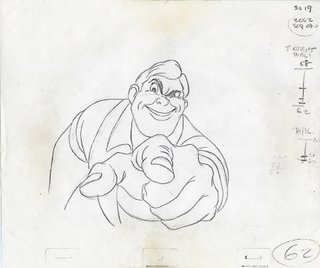More on Clean Up
 The above drawing is from a scene of Brom Bones by Milt Kahl. I've included it here to illustrate how cleanup has changed over the years. When Ichabod Crane was done the process included inking, a technique that has not been used much since ink and paint has been done on computers. Even when the Xerox process was used there was still portions of a character and especially special effects that were still being inked by hand. Having work a little bit on projects that were inked I know that the cleanup artist only had to concentrate on the drawing and not the line quality. The line quality came from the skilled inkers who put the images onto cells. These days clean up in my opinion has gotten too clean. Shows that use software to give their animation a good line many times lose out on the freshness of the drawing. Even once Xerox came into the process many of the animators drawings were lost since studios manly considered the finished scene worth saving. A few enlightened people save some of these roughs and they still exist for us to see and study. This Brom scene shows how the earlier work still has the animators work directly under it. I look at the digital process of a way of keeping the animators roughs while still having a clean version of the scene.
The above drawing is from a scene of Brom Bones by Milt Kahl. I've included it here to illustrate how cleanup has changed over the years. When Ichabod Crane was done the process included inking, a technique that has not been used much since ink and paint has been done on computers. Even when the Xerox process was used there was still portions of a character and especially special effects that were still being inked by hand. Having work a little bit on projects that were inked I know that the cleanup artist only had to concentrate on the drawing and not the line quality. The line quality came from the skilled inkers who put the images onto cells. These days clean up in my opinion has gotten too clean. Shows that use software to give their animation a good line many times lose out on the freshness of the drawing. Even once Xerox came into the process many of the animators drawings were lost since studios manly considered the finished scene worth saving. A few enlightened people save some of these roughs and they still exist for us to see and study. This Brom scene shows how the earlier work still has the animators work directly under it. I look at the digital process of a way of keeping the animators roughs while still having a clean version of the scene.When I approach a clean up I try to concentrate mostly on the drawing and then on the line. If this means doing a blue semi-clean drawing first then I do it. The best way to do this is by not using a light table too much if at all. When you use a light table you tend to draw just lines instead of shapes. In the digital realm I do use a light table but turned down so low as to look no different than if I was seeing through a sheet of paper. This emulates exactly what I would see if I were using paper on an animation disk. The only time I find I must use a light table is when the inbetweens get so close it's hard to see the different lines. In that case I use the table only to get the placement of the lines but make sure I finish the drawing off without the light table to be sure the drawing looks good.


0 Comments:
Post a Comment
<< Home